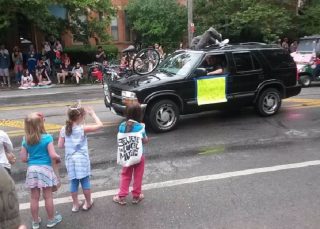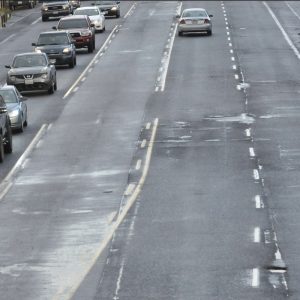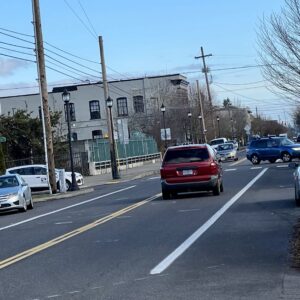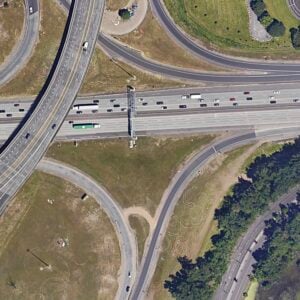
(Photo: Spencer Hackett)
This week’s Monday Roundup is brought to you by the Brompton Urban Challenge, a citywide adventure game/ride coming to Portland this Saturday July 16th. All bikes (and humans) are welcome and all proceeds benefit BikePortland!
Here are the bike-related links from around the world that caught our eyes this week:
Ready, set, Pokemon Go: Nintendo’s new “augmented reality” game has taken over streets worldwide. Expect many interesting headlines in the days and weeks to come.
Parade threat: An anonymous float at a Columbus parade depicted an SUV-bike crash and carried a handwritten sign saying “I’ll share the road when you follow the rules.”
Longevity advice: The oldest U.S. resident, Goldie Michelson, died at 113 in Massachusetts. “I never used a car if I could walk,” she said. “One of the great joys of life was when I sold my car.”
Walking while black: When a Jamaican immigrant moved to the U.S., his favorite activity began to require a “pantomime undertaken to avoid the choreography of criminality.”
Traffic violence: People killed by police during routine traffic stops ought to count as traffic fatalities, argues David Levinson.
Automatic error: A setup error in an Orange County red-light camera resulted in “hundreds” of inaccurate citations over the last year.
Gas tax polling: Young people and poor people are more likely to favor it. Eighty-four percent of Americans 18-24 said they’d favor a 10-cent gas tax to reduce global warming.
Boise bike lanes: A county commission has rejected parking-protected bike lanes in a 3-2 vote. One commissioner called them a “recipe for disaster.”
Rising fatalities: Preliminary figures show that biking deaths rose 13 percent nationally last year, the fastest-growing category. Walking deaths came second at 10 percent.
Street hockey decline: Even on Canadian streets, it’s “somewhat of a dying activity.”
Advertisement
Housing alliance: Angeleno Shane Phillips sketches out what “a pro-housing, pro-tenant platform” might look like.
“Londonize”: The British capital is to public transit what Copenhagen is to biking, argues Daniel Kay Hertz: a model city that feels within reach.
Urban growth: When you look at city population growth in ways that ignore annexation, many “growing” sun belt cities don’t look so hot.
“Gravel grinders”: They’re “the hottest, fastest growing category of bicycles,” says Forbes in a guide to what to look for.
Washougal bike park: The city across the Columbia River from Troutdale is moving to develop a new multi-acre bike park.
Bus collision: Kitsap Transit in Bremerton, Wash., has spent $2.75 million to settle a lawsuit from a woman hit by a bus while biking.
Bike robbery: A man being mugged for his mountain bike in Vancouver fought back with a knife.
Exec fined: Seattle Transportation Director Scott Kubly will be fined up to $10,000 for failing to get a waiver before working with his former employers at Alta Bicycle Share to launch the Pronto system.
If you come across a noteworthy story, send it in via email, Tweet @bikeportland, or whatever else and we’ll consider adding it to next Monday’s roundup.
— Michael Andersen, (503) 333-7824 – michael@bikeportland.org
Our work is supported by subscribers. Please become one today.






Thanks for reading.
BikePortland has served this community with independent community journalism since 2005. We rely on subscriptions from readers like you to survive. Your financial support is vital in keeping this valuable resource alive and well.
Please subscribe today to strengthen and expand our work.
Looks like people everywhere are feeling emboldened to threaten those they feel superior to. I wonder who could be causing that?
The link about the Seattle guy facing a $10K fine instead goes to the grinder bike article. 8:57 am
Thanks Charles. I corrected that. Here’s the link to the Seattle fine article.
Re: Washougal Park: Changes to the park will include adding a quarter-mile dirt track around the perimeter and through the middle of the park. The new layout will also include a beginner’s pump track, which is a loop of dirt berms, as well as three jump lines for beginner, intermediate and advanced bikers.
That sounds so, so amazing. I wish Metro could take a note of this, it’s going to be such a community asset and really designed for all ages and abilities. Good on ’em.
Gateway Green should have been funded,, but the Park’s department rated it poorly since there are not enough household’s within a half mile WALKING distance………
If she cared about bikes, Commisionor Fritz should have over ridden that decision…….but alas.
Gateway green is lacking east-west connectivity. I’ve also encountered groups that camp near the bridge over I-84 on the south end an harass anyone that passes by. Kind of hard for people to get to a community resource when the there are only two access points and they have to run the gauntlet.
Uhh, what about MAX?
If you can manage to hop off the train while it is cooking down the hill at 50mph, more power to you.
Can’t you just get off at Gateway and walk or ride down to the park? It’s like two blocks away.
That doesn’t really help the people east and west of the park. Hundreds of houses are within a mile of the park, but nowhere near the MAX line or Gateway. Gateway green needs more neighborhood connectivity to succeed. The fact that so many homeless live there right now is testament to its isolation.
I live in Parkrose Heights and have no easy way to get there. And from what I’ve seen living down there don’t have much desire to go anyway.
Get off at Gateway TC and take the I-205 path north to the park.
I’m going to send to THPRD in WashCo too. All we have is Eichler Park, a tiny jump park with massive jumps, totally unsuitable for most kids.
Interesting! While I agree that parks would do better to suit all abilities, I’m glad you weighed in because I didn’t even know about the existence of this place. While I am not experienced to go off huge jumps, I find I can often roll the jumps and practice going off just a few. So in short, thanks for heads up that this spot exists!
Good luck. I’m curious to hear what you think of it!
BTW, I once had a conversation with someone at THPRD, lamenting the lack of trails here, and they said, ‘but what about Eichler Park?’ To me, having Eichler Park is like having a driving range but no golf courses. Or a single soccer goal but no soccer fields. Or a batting cage but no baseball fields.
The disparity in facilities is pretty amazing.
“…I wish Metro could take a note of this, …” kate
Metro…is the planning body to ask for something like provision of land designated for mountain bike trails, because Metro is a regional, as opposed to just a city…planning and decision making body. Metro has tabs on land throughout the three counties, Washington, Multnomah, and Clackamas. And the power of voters in all of those three counties together, compared to that of the counties, individually. From over a long period of time, the feeling I get, is that not nearly enough people ask Metro for provision of mountain biking trail, in order to have that request become a high priority in need of being met.
It’s by way of Metro’s action and appeal to people to vote for it, in the tri-county metro area, that the South Tualitan Mtn lands, and the opportunity in future, for some mountain biking, came to be. Though the appeal in general from Metro to the people in the counties, for provision of mountain biking trail, prior to the vote, and in the ballot measure language, for providing mountain biking trail on those lands…was far too subtle/low profile, I think.
Lacking, I think, is some means to a good idea of how many people throughout the metro area…what percent of that areas’ population…would be sufficiently interested in public provision of mountain biking trails, to fork out the bucks to to accomplish that.
The Scott Kubly link goes to the gravel grinder article
Ah fixed
The parade article seems to be linking to the street hockey article instead
Re: the Londonize article:
For a city that claims to have good public transport, it really is a shame that we have exactly zero bus lanes outside downtown. Bus lanes not only make public transport more reliable, they also solve the problem of roadways that are too wide and therefore dangerous. Bus lanes are incredibly cheap given the gains they provide, and could even be implemented on a trial basis on a popular route (that’s not on an ODOT road, that is). I’d like to see PBOT and TriMet experiment with them for frequent-service lines.
Streets that should have them: Powell, Barbur, Burnside, 122nd…
As a very regular transit user, I would agree that 12 minutes (not 15) is probably a good minimum standard frequency to make buses really work for people. I’m glad to see to see TriMet and Metro Transit (here in the Twin Cities) expanding their 15-minute high frequency service, but I do think that in the long run 15 minutes will still not be considered quite good enough. I’ll point out that TriMet doesn’t even have 12 minute frequency on its MAX trains most of the time. One thing I like about Metro Transit’s light rail trains is that they run every 10 minutes, which also just makes them easier to use: if you know a southbound train comes by at :16, you know it also comes by at :26, :36, :46, :56 and :06. Just makes figuring out the schedule sooooo much simpler.
I also agree that making buses faster is also necessary. As an example, on the route that goes from near my house to downtown, in higher density areas it usually stops EVERY SINGLE block, plus the bus is often stopped for a significant time at each stop as multiple people board, dropping average speed well below that of a bicycle. Frankly, it’s kind of agonizing to ride those last two molasses miles into downtown, and I’m usually wishing I was on my bike. The same thing happens with many eastside (and NW) Portland routes as they approach downtown.
Full-blown BRT is great, but expensive and time-consuming to develop. Last month Metro Transit just opened the A-Line, an “arterial BRT” (think of it as “BRT Lite”) service that offers a lot of the speed benefits of full-on BRT at much lower cost and construction time. Stops (which all have heated enclosures and electronic signboards) are spaced 1/4 mile apart, you pay before you board, and there are extra-wide doorways to allow mass boarding and deboarding through both doors at the same time. As a result its speed approaches that of light rail through a similar urban environment. It’s GREAT! I wish every bus line were like this, and I hope TriMet can start doing it too.
MT is planning to add aBRT along its most popular routes at the rate of about one per year going forward – I think my route is 3rd or 4th in line, so looking forward to that. There is some signal prioritization for buses in MT’s aBRT scheme, but not total signal preemption as light rail and “heavy BRT” has.
Full signal preemption and dedicated bus lanes are among the features of full-blown BRT, but harder, more expensive and more politically challenging to develop. “BRT lite,” if you want to call it that, can get you those benefits in much shorter order.
Of course doesn’t solve the problem of bus routes on congested arterials, and I think the most effective solution may not be holding out for fully dedicated bus lanes, but semi-dedicated bus lanes.
One solution used here in Minnesota is that state law allows buses to use freeway shoulders whenever there is congestion. Due to a number of factors (more sprawl and way too many freeways but also a much higher concentration of jobs downtown) Metro Transit has a large number of rush hour express routes that use freeways, and it’s awesome to watch buses rip along the shoulder, bypassing all the stopped traffic. The express route from near my house hops on the freeway about a mile from my house and usually cruises the shoulder for at least part of the route. This gets me downtown in about a third of the time as the nearby local bus route, and probably faster than light rail would cover those 5-6 miles.
Freeway shoulders, which are underutilized much of the time, are one example of buses not having a fully dedicated lane, but still effectively getting one most of the time. In Portland I think we can find other examples of underutilized pavement that could be repurposed: think of those long parking lanes along 122nd (you know the ones, that force the bike lane uncomfortably far from the curb) that hardly ever get used. You could ban parking along those during busy times and turn them into bus lanes. Some lane reconfiguration would be needed (maybe move the bike lane back to the curb as effectively a parking-protected bike lane, with the parking replaced by buses during rush hour). Of course you may still need fully dedicated right of way approaching busy intersections, but I think there are ways you can get 90% of the benefit of dedicated lanes by sharing the space with other lanes that aren’t fully used.
This is a great post, GlowBoy–chock full of good ideas. Even if it weren’t full of good ideas I’d like it simply for this euphonious phrase– “those last two molasses miles into downtown.” 🙂
ten cent gas tax = reduce global warming; it is too bad that people are presented with such ridiculous, misleading, even mendacious comparisons. If we take the threat of climate change seriously we need to phase out the automobile yesterday, not contemplate adding a tax that is so piddly it doesn’t even register in the week-to-week fluctuations of the price-at-the-pump.
Exactly. A small tax does nothing to reduce demand and perpetuates FUIGM climate change incrementalism. Based on current trends we will exceed Paris accord CO2e emission thresholds purely from agriculture alone in a few decades. The complete absence of urgency over this issue is depressing. I suspect humanity is going to learn the cause of the Fermi paradox the hard way.
A $.10 per gallon tax is far too little but ultimately cost is one of the few things that actually cause people to change behavior. When gasoline prices went up a few years ago the average fuel economy of new purchased cars increased every month for a couple of years and people started buying electric vehicles and driving much less. When gasoline prices dropped dramatically the average fuel economy of new purchased cars started dropping again and the sales of hybrid and electric cars have plummeted. Miles driven per year also has increased now that fuel is cheap.
Cigarettes are another example where increased cost due to taxes have dramatically reduced use. Nobody paid any attention to the warning labels or studies but when a pack of cigarettes cost 3 times as much as they used to people use a lot less.
Non-renewable fuel sources need to have taxes slowly and predictably increased until the users of those fuels pay the true cost of the pollution and use. At the same time any imported goods that are made using non-renewable energy needs to be taxed also. Too often rich countries like the USA ban or make a process too expensive to be done domestically (think plating process like cadmium or chromium) but that just drives the process to a place that has no pollution enforcement and ultimately the planet is more polluted.
>> Non-renewable fuel sources need to have taxes slowly and predictably increased until the users of those fuels pay the true cost of the pollution and use. <<
100% in agreement. Everyone needs to know that the price of carbon-based fuels will be going up relentlessly, and the sooner they decarbonize their life, the better. The downside of this is, of course, that those with fewer resources will be less able to change, and it will have an enormous regressive impact. But I don't know any other way to accomplish this critical goal.
I think it was social stigma more than cost that drove people away from smoking (at some point, smoking became a "lower class" thing to do). The price increases probably dissuaded some younger people from taking up the habit, and may have given people that extra reason to quit, but I don't think it was the fundamental driver of what is, I believe, a great public health success story.
predictably, yes; slowly?! no way.
Why on earth would we—in 2016—be advocating increasing the tax on the substance that is wrecking the present, never mind future, habitability of our planet SLOWLY? We’ve done these remedial things slooooowly for all of my life and look where it has gotten us.
It has to be slow but predictable to give people time to adapt and make the investments needed to change their consumption patterns. Obviously not so slow that the changes can be universally ignored for decades.
“It has to be slow but predictable to give people time to adapt and make the investments needed to change their consumption patterns.”
Oh, right.
Except that a one-time ten cent hike doesn’t lead anyone to adapt or make investments. This is ridiculous.
If we said we’d hike it ten cents every month going forward, compounding that would be useful, and would motivate changes in behavior and investments, but everything else I’ve seen doesn’t come close.
People will get used to slow incremental change, but a big change would change behavior immediately.
And we have decades upon decades of incremental change behind us with basically nothing to show for it, when it comes to the stuff that matters.
Not impressed.
The one-time 10 cent gas tax is not at all what I’m talking about.
But perhaps the difficulty getting that passed is some indication of how we, as a society, will respond to proposals for far higher, long-term tax increases.
Someone’s got to propose a more prudent, realistic pathway. I’m not inclined to conclude that this is the best we can do when we haven’t even tried.
A few years back Novick set up a telephone poll in which he was exploring how to raise money for fixing our streets. In the first poll a gas tax did pretty well, but for two+ years afterward he lied and said it had faired poorly, was off the table, never got mentioned again seriously. Everyone parroted this tired, self-fulfilling line. Then, when his first however many iterations worth of proposals crashed and burned he decided maybe a gas tax wasn’t such a pointless way forward after all. This is not the kind of leadership we need, and it would I think be foolish to conclude anything about what we as a society, a public, would agree to when those charged with providing direction are so inept and clueless.
Maybe when we get a new president, we’ll finally have the kind of bold leadership we need to solve our problems!
😉
Government studies have concluded that taxes on cigarettes are one of the most effective ways of reducing smoking and that “On average, a price increase of 10% on a pack of cigarettes would reduce demand for cigarettes by about 4% for the general adult population in high income countries”.
http://www.ncbi.nlm.nih.gov/pmc/articles/PMC3228562/
MIT found that gas taxes are 6X to 14X more effective at reducing gasoline use than regulation of average fleet economy (CAFE) standards:
https://www.washingtonpost.com/news/wonk/wp/2013/02/22/study-gas-taxes-are-six-times-as-effective-as-stricter-fuel-economy-standards/
That doesn’t explain why the wealthy stopped smoking before the poor, or why the poor are far more likely to smoke than their wealthier peers. If it were primarily a cost issue, I’d expect smoking to have become an indulgence of the elite.
I don’t doubt price is an important factor, but I think social stigma is even more important.
Please forgive the aside…. Apparently, smoking is cool again. Dammit.
http://www.salon.com/2013/11/09/teens_have_started_smoking_again_because_they_think_its_cool_partner/
I’ve noticed a lot more saucy walking smokers in Portland. I can’t seem to walk a block in downtown anymore without involuntarily smoking half a pack of cigarettes. Loads of millennials in SE smoking too–we lived next to a house full of young chain smokers (recently moved) who’d come out hourly to smoke on the porch. We watched one 20-something beardly guy grey and crust over like King Theoden in the span of a year +. Ugh.
I hate to break it to you, because the simple model of higher priced gasoline being a trigger for less driving is so attractive, but per capita driving miles began declining four years before the price increases of 2008, and total miles driven also hit a nadir prior to 2008.
I’m not saying that higher fuel cost doesn’t change miles driven or vehicle choice, it clearly does. However, there is more going on than simple price-based choices. That said, we clearly need to dramatically increase the price of gasoline, preferably with a tax that is used to improve people’s perception of their ability to get around without personal cars.
Keeping it in the ground is only one essential action…and one that we are are utterly failing. To be blunt, my read of the literature is that we are f*cked and that as models are refined we become even more f*cked.
https://www.youtube.com/watch?v=fcZWZhUozr4
When was it sold as anything more than a way to raise revenue to repair roads and improve safety??
mis-linker strikes again
Parade threat link goes to Street Hockey story
Not fond of that lead photo, except the girl making the forehead “loser” L at it.
Parade story article in the link is titled “Doo Dah Parade entry depicting bike crash offends cyclists”, as though it was a normal thing to do and some fringe group is pearl clutching.
Right, it should offend EVERYBODY.
Aspects of the article Walking While Black were familiar to me.
Having to be fearful of attacks by others while cycling and now more recently having to see the faces of people who now consider me to be threatening them. It’s upsetting as I mean no one any harm. I now have to do “choreography” when cycling to try to outguess what prejudice they might have about cyclists.
At least I can dismount and become a white pedestrian and “pass”.
As someone who is often mistaken for middle eastern and who has commuted significant distances by bike for over 35 years (only the last 4 with access to bike infrastructure), I doubt there is any meaningful similarity. There are people who don’t like cyclists, but they don’t find them threatening.
I don’t pretend to know what it’s like to be black, but I have plenty of experience being singled out by cops/security/idiots as well as riding many tens of thousands of miles in non cycle friendly areas.
The bike thing is nothing in comparison. Especially in Portland.
Why do “gravel grinders” need disc brakes? Those all just look like normal road bikes with slightly wider fork clearance, otherwise. You can fit some pretty knobby tires with long-reach calipers or cantis.
Better brake modulation so you have better control in loose surface conditions, a bike the easily locks up would not be enjoyable to ride on gravel.
Also braking surfaces will likely stay a bit cleaner and not wear out as quickly. When they do wear out, rotors and pads are cheaper than new rims.
…So I suppose they don’t “need” them, in the same way Mountain Bikes don’t need them but obviously perform better with them.
I thought it was kind of charming that Forbes thinks that bike tires run from 26 to 50 _centimeters_ wide. I guess this topic is kind of outside their wheelhouse though.
It’s true that one need not have disc brakes to gravel grind, as those few of us who have been doing it for decades can attest to. However, even I may break down (ahem) and purchase a bike with disc brakes within a couple of years, if only to more easily use some nice 2.4″ tires.
Equipment changes, and sometimes the newer stuff really is an improvement on what has been tried and true.
Well yeah, if it’s always DRY out when you do your gravel-grinding, rim brakes might be fine …
I switch between Reynolds carbon clinchers with slicks for road riding and 29er wheels with 35mm CX tires on my CX bike. The rims are very different in width and having discs means an easy swap. Minor additional benefit to what bradwagon already said, though.
“Walking while black” piece is powerful. Got to remember to put that writer on my watch list.
Agreed; it was well worth reading.
Yes, everyone should read ‘walking while black’. Something to be learned by every skin tone and shade.
The Seattle Times story about the settlement arising from the Kitsap Transit bus and person on a bike collision in Bremerton, Wash, doesn’t have much in the way of details about the collision. There is a link in that story…
http://www.kitsapsun.com/news/local/kitsap-transit-settles-case-with-bicyclist-36e71024-7166-09f7-e053-0100007f354c-385756211.html
…to a Kitsap Sun story, offering a few more details. It says the person on the bike was riding on the shoulder of a road when hit by the side of the bus. To the question of responsibility for the collision…there are a couple items to consider from those stories…the first from the Stimes:
“…Kitsap Transit spokesman Sanjay Bhatt called the incident a tragic accident. He says their investigation found the driver was not responsible for the crash and says the insurance pool settled to avoid the uncertainty of a trial. …” Stimes
…and from the Ksun ( Bhatt, is Sanjay Bhatt, spokesperson for the transit company):
“…Bhatt called it a “tragic accident.”
Kitsap Transit conducted an investigation and found that the driver was not responsible for the collision. The insurance pool elected to settle the case to avoid the uncertainty of a jury trial, he said. …” Ksun
The collision is reported to have occurred in what I’d basically consider to nearly be daylight, though granted, it was the early morning hours of 6:30 am in May. More details about the collision, and why people that conducted the transit company investigation, came to find the person driving was not responsible for the collision, would be good to know.